In agile development, user stories are crucial as they encapsulate the user requirements, guiding the development team to create valuable product features. The scrum user stories example demonstrates their effectiveness in breaking down larger structures into manageable tasks. This agile user stories approach ensures that the development team effectively aligns with the product roadmap and meets user requirements. It enables streamlined sprint planning and fosters clear communication among the agile team.
Aloa, an expert in software outsourcing, leverages scrum user stories example to streamline project workflows. With Aloa's proficiency in hiring developers skilled in various programming languages and frameworks, clients are assured that their projects will be delivered on time, within budget, and with high quality. Aloa's commitment is rooted in understanding the cost of delay and the importance of agile estimation in the agile framework, making it a trusted partner in software development.
This blog delves deep into various scrum user stories example, offering templates and use cases to illustrate effective project management strategies. Afterward, you will comprehensively understand how to apply this scrum user stories example in your projects, ensuring that your development team can meet the desired outcome with precision and creativity.
Let's dive in!
What Are Scrum User Stories?
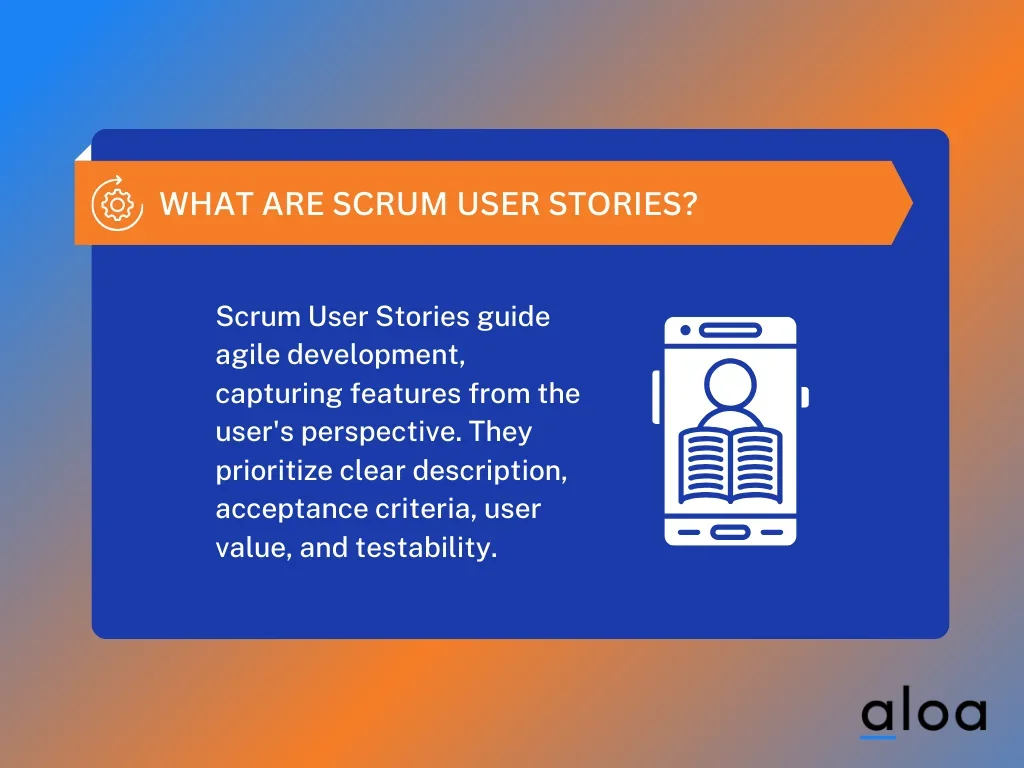
Scrum user stories are concise narratives from the end user's perspective representing features or functionalities. This scrum user stories example illustrates their effectiveness in capturing user requirements and guiding agile development processes. In Scrum methodology, these stories are vital communication tools, fostering collaboration and aligning development efforts with user needs.
Here are five components of a good user story:
- Clear and Concise Description: A good user story should clearly and concisely describe the desired feature or functionality.
- Acceptance Criteria: It should include specific acceptance criteria defining when the story is complete and meets the user's expectations.
- User Value: The user story should articulate its value to the end user, addressing their needs or solving a problem.
- Prioritization: Each user story should be prioritized based on its importance and value to the user and the business.
- Testability: A good user story should be testable, allowing for validation of its implementation through testing processes.
Scrum user stories exemplify a user-centric approach to development, driving collaboration, prioritization, and alignment with user needs in agile projects. A well-crafted user story is a blueprint for development efforts, ensuring teams deliver user value efficiently and effectively.
Scrum User Stories: Example, Use Cases, and Templates
Scrum user stories are foundational in agile methodologies, bridging the gap between technical requirements and customer needs. In this guide, we will explore six scrum user stories example, use cases, and templates to illustrate how they can be applied in various project scenarios.
Through these scrum user stories examples, we'll offer practical insights and tools for integrating user stories into your agile workflow, enhancing collaboration, and driving project success.
1. User Story for E-commerce Checkout Process
A scrum user stories example for an e-commerce checkout process encapsulates a customer's need for a streamlined, efficient online shopping experience. This narrative framework highlights the importance of user-centered design in software development, focusing on enhancing usability and satisfaction.

The e-commerce checkout process user story ensures users can smoothly navigate the purchasing journey, which is crucial for reducing cart abandonment rates and boosting sales.
Use Cases of E-commerce Checkout Process
Implementing this scrum user stories example can revolutionize the e-commerce checkout experience, through:
- Simplifying User Interface: Ensures a clutter-free checkout page, enhancing user navigation.
- Multiple Shipping Options: Offers users flexibility in shipping methods, accommodating diverse needs.
- Guest Checkout Feature: Allows users to complete purchases without creating an account, speeding up the transaction.
- Payment Security Enhancements: Increases customer trust through secure payment gateways.
- Personalization of Checkout: Tailors the checkout experience based on user preferences and past behavior, promoting repeat business.
Each use case demonstrates how a well-crafted user story can lead to actionable improvements in the e-commerce checkout process, directly impacting the platform's success by addressing real user requirements.
2. User Story for Social Media Platform
A social media platform scrum user stories example focuses on enhancing user engagement and satisfaction through personalized and secure interactions. Social media platforms can foster a more engaging and loyal community by addressing specific user desires, such as improved privacy controls or more intuitive content discovery.

Customizable privacy settings on social media platforms empower users to tailor their online experience according to their preferences, enhancing their sense of control and security.
Use Cases of Social Media Platform
Adopting this scrum user stories example in a social media context can significantly enhance user experience and platform engagement, including:
- Customizable Privacy Settings: Empowers users to control who sees their content, fostering a safer online environment.
- Enhanced Content Discovery: Uses algorithms to present relevant content, making user interactions more enjoyable and engaging.
- Real-Time Notifications: Keeps users informed about critical updates and interactions, encouraging continuous engagement.
- Cross-Platform Sharing: Allows users to seamlessly share content across social media platforms, expanding their reach.
- Interactive Story Features: Engages users with temporary content options, encouraging more spontaneous and frequent content sharing.
These use cases illustrate the potential of incorporating specific user stories into the development process of social media platforms. Focusing on the needs and preferences of the end-user, social media platforms can innovate and adapt in ways that enhance user satisfaction and drive engagement.
3. User Story for Online Learning Platform
A scrum user stories example for an online learning platform focuses on the learner's desire for an engaging, personalized, and accessible education experience. This highlights the necessity of incorporating features catering to diverse learning styles, facilitating easy access to resources, and supporting progress tracking to enhance learning.
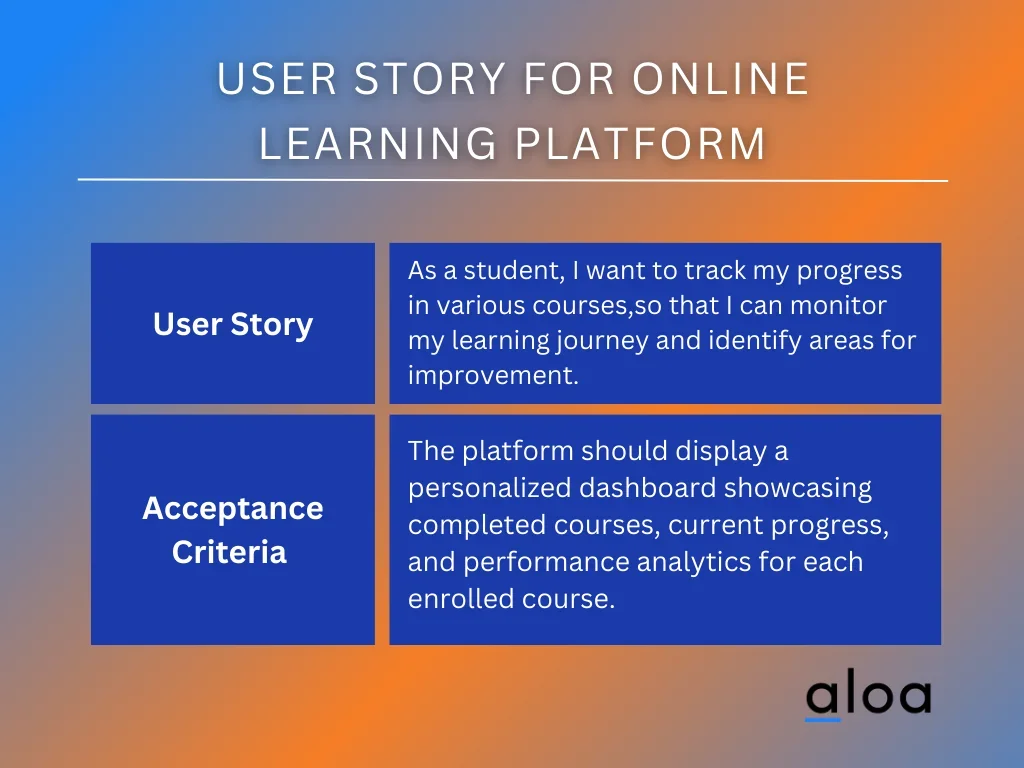
Progress tracking features on online learning platforms enable users to monitor their learning milestones and identify areas for improvement, fostering a sense of achievement and motivation.
Use Cases of Online Learning Platforms
Executing this scrum user story example can transform the online learning experience through several key applications:
- Custom Learning Paths: Learners can tailor their education journey to their goals and interests.
- Interactive Content: Engages students with multimedia resources, quizzes, and interactive modules for a richer learning experience.
- Mobile Accessibility: Ensures learners can access courses and materials on the go, enhancing flexibility.
- Social Learning Features: Facilitates community learning through forums, group projects, and peer reviews.
- Progress Tracking and Feedback: Provides learners with insights into their advancement and areas for improvement, motivating continued learning.
These use cases illustrate the impact of effectively implemented user stories on the functionality and user satisfaction of online learning platforms. Addressing specific learner needs can significantly improve engagement, retention, and educational outcomes.
4. User Story for Health and Fitness App
A health and fitness scrum user stories example app helps the user's aspiration to lead a healthier lifestyle through personalized, intuitive, and interactive tools. This story underlines the significance of integrating features that motivate users, track their progress, and provide customized health and fitness guidance. Fitness apps can significantly enhance user engagement and wellness by focusing on individual health goals and preferences.

Personalized fitness goals in health and fitness apps empower users to set achievable targets and track their progress over time, motivating them to maintain healthy habits and reach their fitness objectives.
Use Cases of Health and Fitness Apps
Adopting this scrum user stories example can elevate the user experience in health and fitness apps by having:
- Personalized Workout Plans: Generates customized workout schedules based on the user's fitness level and goals.
- Nutrition Tracking: Offers tools for logging meals and monitoring nutritional intake to support diet-related objectives.
- Activity Monitoring: Utilizes sensors and manual inputs to track exercises, steps, and overall physical activity.
- Goal Setting and Reminders: Enables users to set fitness and health goals while providing timely reminders to keep them on track.
- Community Challenges: Engages users with community-driven challenges and achievements to foster a sense of competition and camaraderie.
Through these use cases, it's evident how a well-crafted user story can guide the development of features that address real user needs in health and fitness apps. Focusing on personalized experiences, these apps support users in achieving their health and fitness goals and promote a more active and health-conscious lifestyle.
5. User Story for Project Management Software
A scrum user stories example for project management software emphasizes the project team's need for a cohesive, efficient, and transparent tool to manage tasks, deadlines, and collaborations. This narrative stresses the importance of features that streamline project planning, enhance team communication, and provide real-time updates on project status.
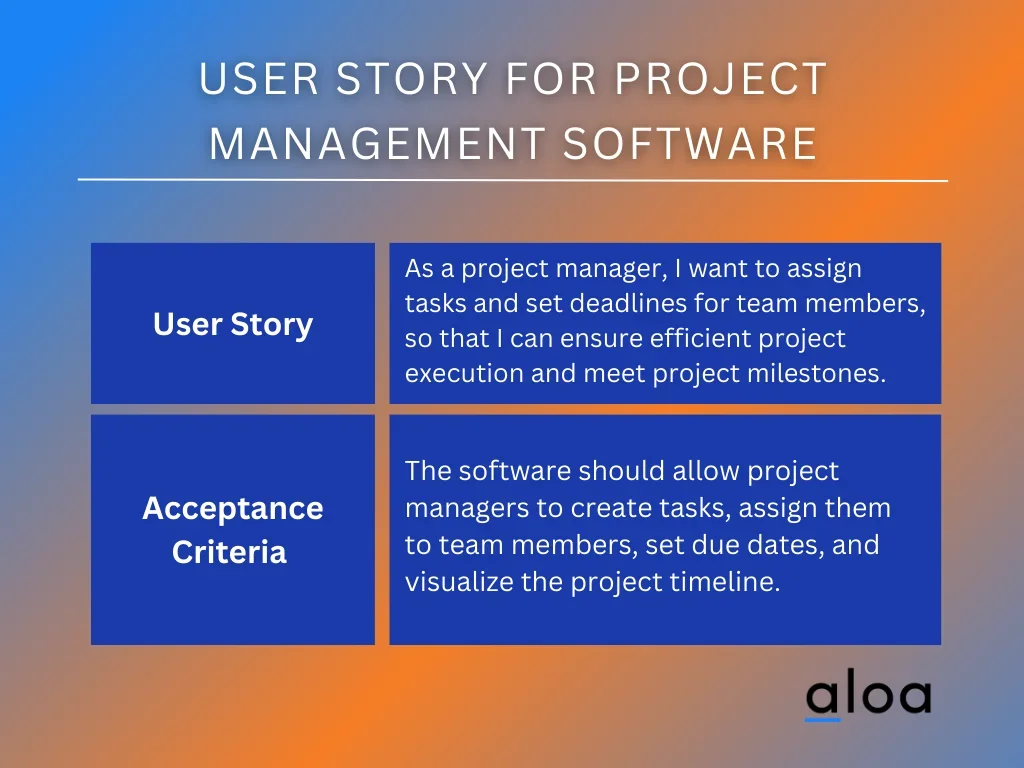
Task assignment functionality in project management software allows project managers to distribute work among team members efficiently, ensuring clear accountability and streamlined project progress.
Use Cases of Project Management Software
Implementing this scrum user story example can significantly improve project management through several strategic applications:
- Task Assignment and Tracking: Facilitates the clear assignment of tasks to team members and tracks progress toward completion.
- Collaborative Workspaces: Offers shared spaces for documents, discussions, and feedback, promoting team synergy.
- Deadline Alerts and Scheduling: Keeps the team on schedule with deadline reminders and a visual project timeline.
- Resource Allocation: Enables managers to allocate and monitor resources effectively, ensuring projects stay within budget.
- Progress Dashboards: Provide at-a-glance views of project status, highlighting achievements and areas needing attention.
These use cases demonstrate the pivotal role of user stories in shaping project management software development. Directly addressing the needs and challenges of project teams, these platforms can offer solutions that not only streamline workflow but also foster a collaborative and productive project environment.
6. User Story for Customer Support Chatbot
A customer support chatbot scrum user stories example highlights the user's need for immediate, accurate, and 24/7 assistance without the wait times associated with human agents. This story emphasizes the importance of integrating AI-driven solutions to enhance customer service, offering instant responses to frequently asked questions and providing seamless escalation to human support when necessary.
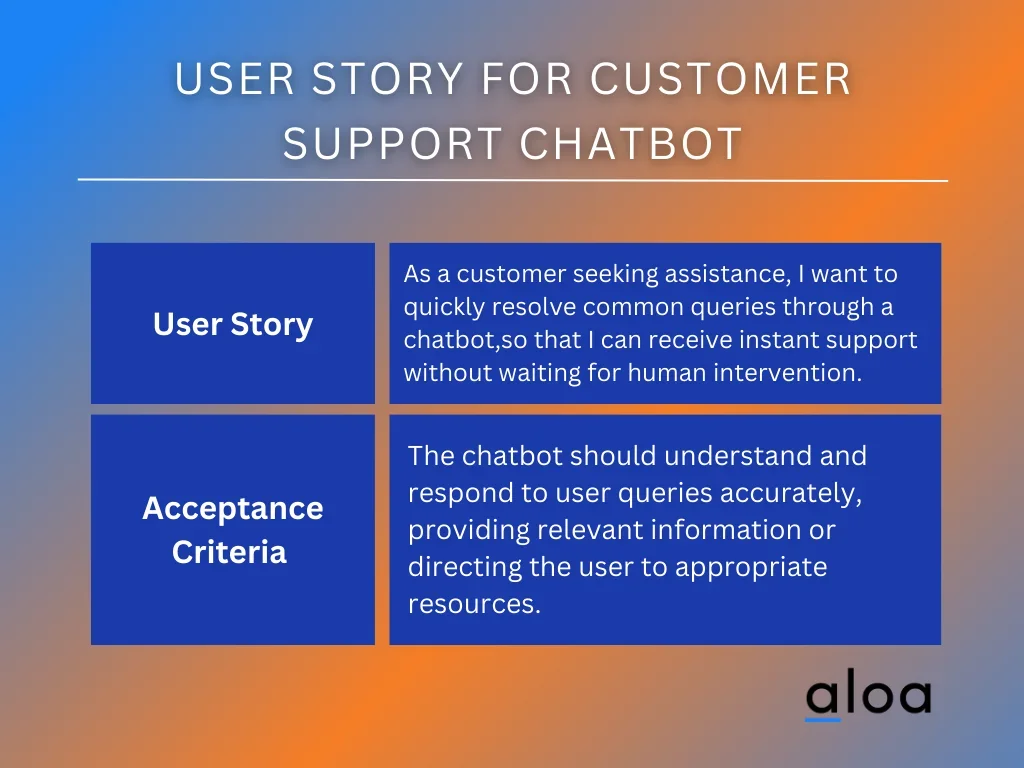
Utilizing a customer support chatbot streamlines user inquiries, provides instant responses, and frees human agents to focus on more complex issues, ultimately enhancing overall customer service efficiency.
Use Cases of Customer Support Chatbot
Implementing this scrum user stories example can transform customer service experiences in several impactful ways:
- Instant Query Resolution: Delivers immediate answers to common questions, reducing wait times and improving user satisfaction.
- Order Tracking Updates: Provides users real-time updates on their orders, enhancing transparency and trust.
- Feedback Collection: Facilitates gathering customer feedback directly through the chat interface, informing service improvements.
- Personalized Recommendations: Offers product or service suggestions based on user interactions, driving sales and engagement.
- Issue Escalation: Seamlessly escalates complex issues to human agents, ensuring users receive help.
These use cases illustrate the diverse functionalities that a well-designed customer support chatbot can offer, directly addressing users' expectations for quick, reliable, and accessible customer service. Businesses can create more engaging, efficient, and effective customer support systems by leveraging AI to meet these needs.
Benefits Of Using Scrum User Stories for Your Project
In project management, incorporating agile methodologies has become a cornerstone for success. One key component of the agile framework is using Scrum user stories, providing a streamlined approach to development. Let's explore the benefits of integrating scrum user stories into your project.
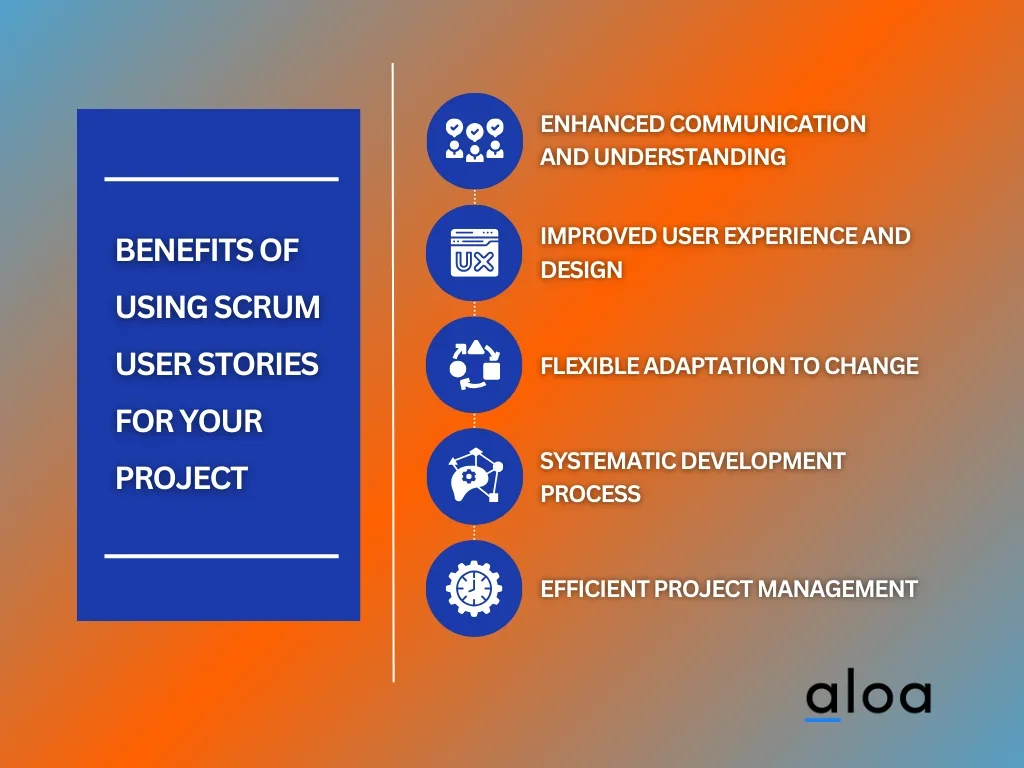
Enhanced Communication and Understanding
Scrum user stories clearly and concisely communicate project requirements between the product owner and the development team. Using a simple template, such as index cards or sticky notes, everyone involved gains a shared understanding of what needs to be done. This ensures the team members are on the same page regarding the user's perspective and the desired outcome.
Improved User Experience and Design
Scrum user stories focus on the product's user experience (UX) and user interface (UI) design aspects. In collecting user research and incorporating it into the user stories, the team can prioritize features that align with user needs and preferences. This approach facilitates the creation of compelling user stories that address the end user's requirements, resulting in a product that delivers a seamless and intuitive experience.
Flexible Adaptation to Change
In product development, requirements often evolve throughout the development process. Scrum user stories allow this flexibility by breaking down more oversized work items into smaller stories. This enables the team to adapt and prioritize tasks based on changing needs and stakeholder feedback. With a product backlog filled with user stories, the product manager can easily reprioritize tasks and adjust the project roadmap as necessary to accommodate new features or changes in direction.
Systematic Development Process
Breaking down large work items into smaller stories promotes an incremental and iterative approach to development. This approach allows the development team to focus on delivering smaller, manageable increments of functionality, making it easier to adapt to changing requirements. Each user story becomes a building block, contributing to the project's success. This systematic and adaptable approach is particularly beneficial in today's fast-paced development environment.
Efficient Project Management
Scrum user stories are an essential part of an agile approach to project management. The team can prioritize tasks based on their importance and complexity by breaking the project into stories. This iterative development process allows continuous improvement and ensures that the most valuable features are delivered early and often. With the guidance of a certified scrum master, the team can effectively manage the project backlog and track progress toward the project goals.
Key Takeaway
The exploration of scrum user stories example across various domains underscores the critical role of these narratives in the agile development process. Scrum user stories exemplify a user-centric approach that enhances project management by ensuring the development team remains aligned with the end user's needs and expectations.
Integrating scrum user stories into agile practices can significantly improve project outcomes. These stories bridge technical requirements and customer benefits, enabling teams to deliver products that truly resonate with users. Organizations can also foster a more responsive, flexible, and user-focused development environment by adopting this scrum user stories example as a fundamental part of an agile approach.
For project managers, software developers, and team leads looking to deepen their understanding of agile methodologies and enhance their project management skills, signing up for the Aloa email list presents an excellent opportunity. Aloa offers invaluable insights and resources on agile practices and project management aimed at empowering professionals to achieve better project outcomes.

